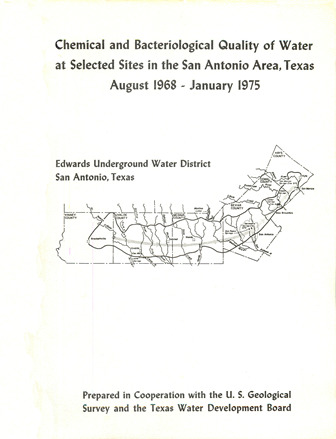Chemical and Bacteriological Quality of Water at Selected Sites in the San Antonio Area, Texas August 1968-January 1975

| Author | Reeves RD (US Geological Survey, in cooperation with the Edwards Underground Water District and the Texas Water Development Board) |
| Year | 1976 |
| Description | Surface and groundwater quality monitoring in the San Antonio area, 1968-1976. Note: Page-size and full-size plates are at the end of the document. |
| Publisher | Edwards Underground Water District |
| Location | Edwards Aquifer, Balcones Fault Zone, San Antonio Segment, and associated surface water |
| Cover | View Download |
| File | View Download |
| Summary |
|
Water samples collected from 161 wells and 3 springs in the Edwards aquifer and at 36 sites on streams that cross the recharge zone of the aquifer were analyzed for more than 50 properties or constituents, most of which affect the suitability of the water for domestic use. The samples were analyzed for bacteria; major inorganic constituents; minor elements, including heavy metals; pesticides; and several other properties or constituents. None of the concentrations of major inorganic constituents, minor elements, or pesticides exceeded the U.S. Environmental Protection Agency’s “maximum contaminant levels” for public water systems or “maximum.acceptable limits” for raw water used for drinking-water supplies. The concentrations of dissolved solids in samples from wells and springs ranged from about 200 to 527 mg/l (milligrams per litre) and the dissolved chloride and dissolved sulfate concentrations ranged from 3.7 to 130 mg/l and from 0.0 to 83 mg/l, respectively. The total nitrite plus nitrate nitrogen and total phosphorus concentrations in the ground water ranged from 0.00 to 5.5 mg/l and from 0.00 to 0.12 mg/l. The water is very hard (greater than 180 mg/l as calcium carbonate) and is of the calcium bicarbonate type. The recharge zone or water-table part of the aquifer is characterized by areas of thin soils or bare rock, and the aquifer is susceptible to contamination in these areas. The presence of fecal coliform and fecal streptococci bacteria, the variations in the number of total coliform bacteria, and the concentrations of total nitrite plus nitrate nitrogen and total phosphorus in samples from some wells in the water-table part of the aquifer show that contamination can and does occur. However, the data indicate that such contamination at the present time (1976) is very localized, and is small in comparison to the volume of water available for dispersion and dilution. In the artesian zone of the reservoir, samples from improperly constructed wells have contained coliform bacteria; but samples collected from properly constructed and sealed wells were free of coliform bacteria. There is no evidence of significant degradation of water quality throughout most of the ground-water reservoir, but the data collected during this study indicate that the nearly unrestricted movement of liquids· from the surf ace to the aquifer in the recharge zone presents an ever-present hazard if surface spills of toxic substances should occur. In addition, the many poorly-constructed wells in the artesian part of the aquifer could allow toxic substances to enter the aquifer. |
Search for Documents
Advance Search
Explore EAA's Scientific Reports
- All Reports
- Groundwater Movement
- Geomorphology and Caves
- Weather Modification
- Geology
- Water Use and Conservation
- Geochemistry
- Water Resources Planning and Management
- Floods and Drought
- Water Quality
- Climatology
- Surface Water / Groundwater Relationship
- Biology
- Springs, Groundwater Discharge
- Archaeology
- RZ Protection
- Aquifer Levels
- Remote Sensing
- Precipitation
- Overview Studies
- Modeling
- Hydrology and Hydrogeology
- History
- Groundwater Recharge, Recharge Zone
